It is no secret that roasted chestnuts are synonymous with the holiday season. But for me, growing up in Turkey, starting from early October all the way through late December, roasting chestnuts in the oven and peeling and snacking on them in front of the TV was a favorite pastime.
Today, we are going back to basics and discovering how to make roasted chestnuts in the oven using my mom’s method. I think this is the easiest way to cook chestnuts.
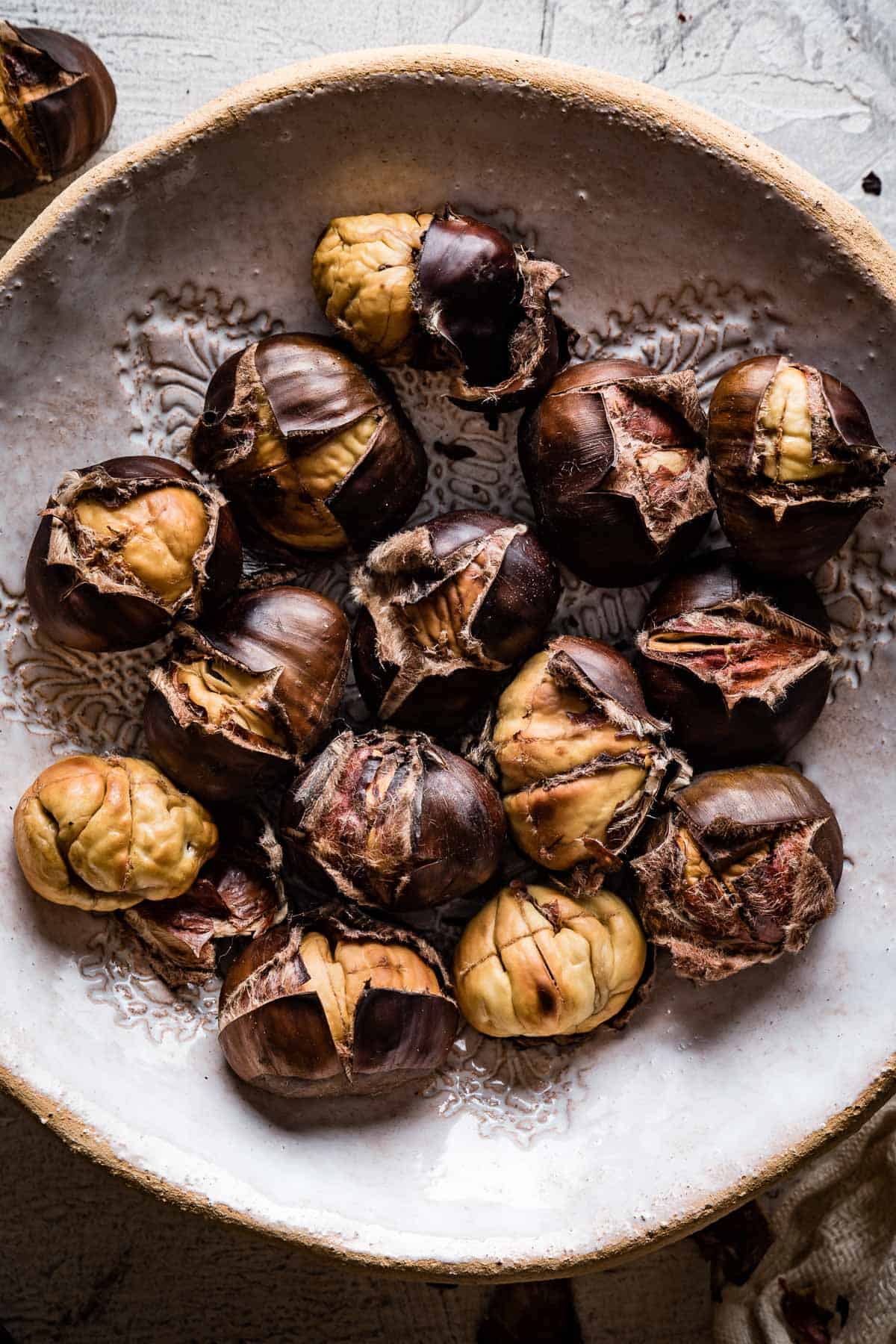
Table of Contents
- Where to buy and what type of chestnuts are used for roasting?
- What to Look For When Buying Chestnuts
- How To Prepare Chestnuts for Roasting
- How to roast?
- How To Peel Roasted Chestnuts?
- How To Store?
- Seasoning Ideas:
- How to Serve – What To Do With Chestnuts?
- Expert Tips
- FAQs
- Other Snacks Recipes You Might Also Like:
- How to Roast Chestnuts in Oven – Oven Roasted Chestnuts Recipe
However, this post is a sequel to my three other favorite methods – Boiled Chestnuts, Roasting Chestnuts in An Open Fire, and Air Fryer Chestnuts. So, if you want to branch out and try different methods to cook your own chestnuts, be sure to check them out as well.
Where to buy and what type of chestnuts are used for roasting?
You can find fresh chestnuts during the fall and winter months in your local grocery store and even in farmer’s markets.
Most US grocery stores carry either American chestnuts (most likely grown in Michigan), Chinese chestnuts, or European chestnuts (mainly from Italy). While they are not sold at markets, I think it is important to mention that horse chestnuts are not edible as they are toxic. (Source)
As I was working on this recipe, I was able to get my hands on Chinese and Italian chestnuts. I found that Italian chestnuts were easier to work with especially when it comes to peeling them after they were roasted. It was almost impossible to peel Chinese chestnuts and I had such a hard time getting them to open up even after the cooking time was completed.
Unfortunately, where I live (Atlanta, Georgia), American chestnuts are not widely available. But if you can get your hands on them, they will work just as well.
What to Look For When Buying Chestnuts
As it is with any 1-ingredient recipe, the quality of the ingredient determines the fate of the end product. It is imperative to know how to pick out good chestnuts for the most delicious and evenly roasted chestnuts. Below is what you should look for:
- If you can, I recommend hand picking chestnuts to ensure that they are equal in size. Since we are roasting them in the oven, chestnuts of even size will roast at the same rate.
- Look for those that are plump, smooth, shiny, and blemish and mold free. Feel it in between your fingers to make sure the skin is not dry.
How To Prepare Chestnuts for Roasting
Preparing chestnuts for cooking takes a bit of advance planning but I promise it is worth it. Simply:
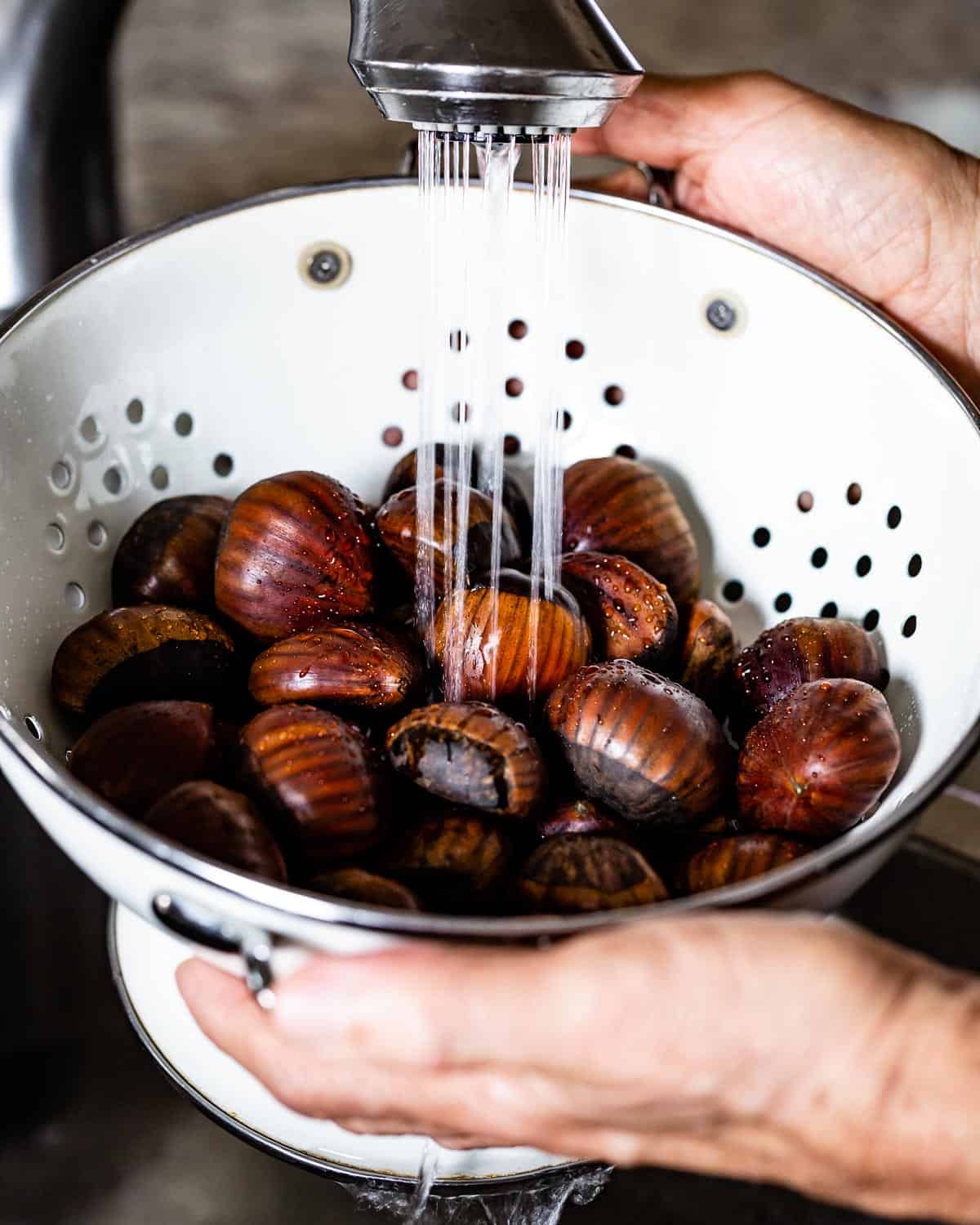
- Rinse: Wash chestnuts under cold water to get rid of any debris.
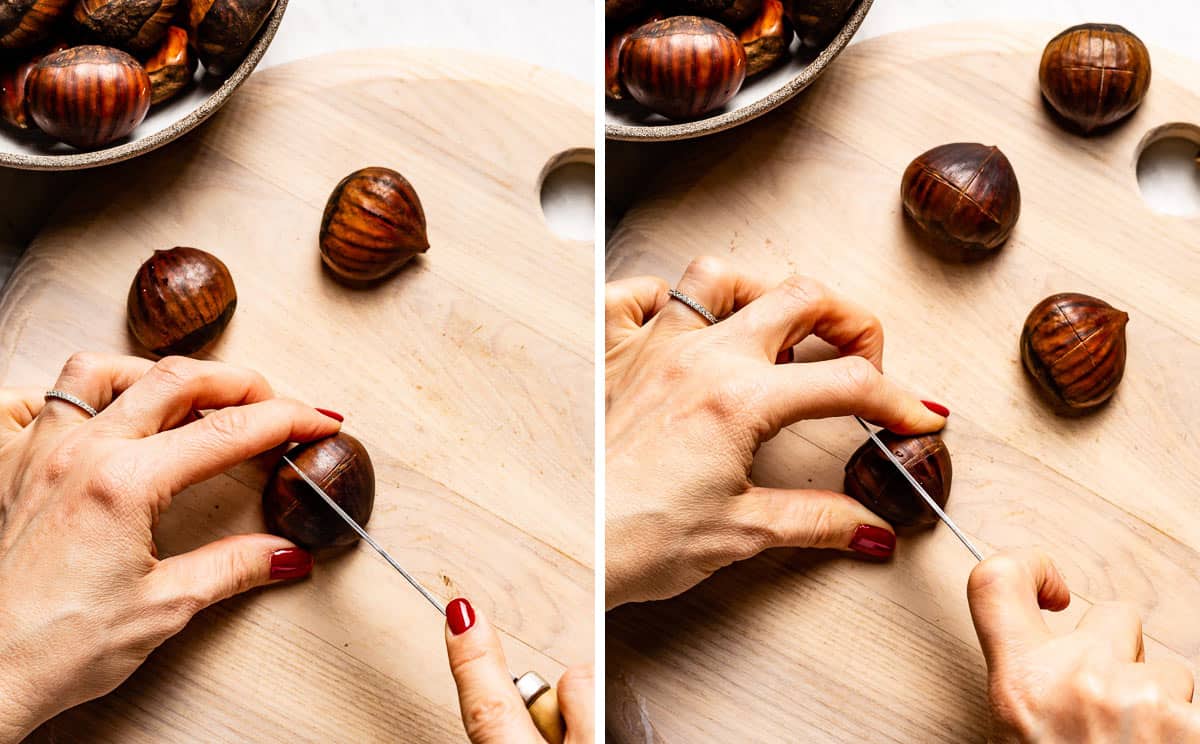
- Score: Place the flat side of the chestnut down on a cutting board with the rounded side (aka the belly side) facing up. Hold the chestnut firmly and cut horizontally across the rounded side using a sharp paring knife or a chestnut knife, if you have one. Then turn the chestnut 90 degrees and make a second cut forming an “X”. As you are cutting, do your best not to score the inner skin. Continue with the rest of the chestnuts.
- Soak: Transfer the now-cut chestnuts into a bowl. Cover with cold tap water and let them sit for an hour. Do not skip the soaking as it plays a crucial role in easy peeling later on.
How to roast?
- Preheat the oven: My preferred temperature to roast chestnuts in the oven is 425 degrees F. So go ahead and preheat the oven.

- Roast chestnuts: Drain chestnuts and place them on a baking sheet pan in a single layer. Roast for 25-30 minutes keeping a close eye on them and turning a few times, if necessary. They should be fully roasted when the skins have pulled back/opened and the flesh inside has softened.
While I listed the roasting time as 25-30 minutes, I recommend that you keep an eye on the chestnuts after the 20-minute mark. In my experiments, some chestnuts were fully opened while the others were not, even after the full 30 minutes of roasting. So, it is a good idea to remove the ones that are fully opened and let the rest bake for a little longer, if necessary.
How To Peel Roasted Chestnuts?
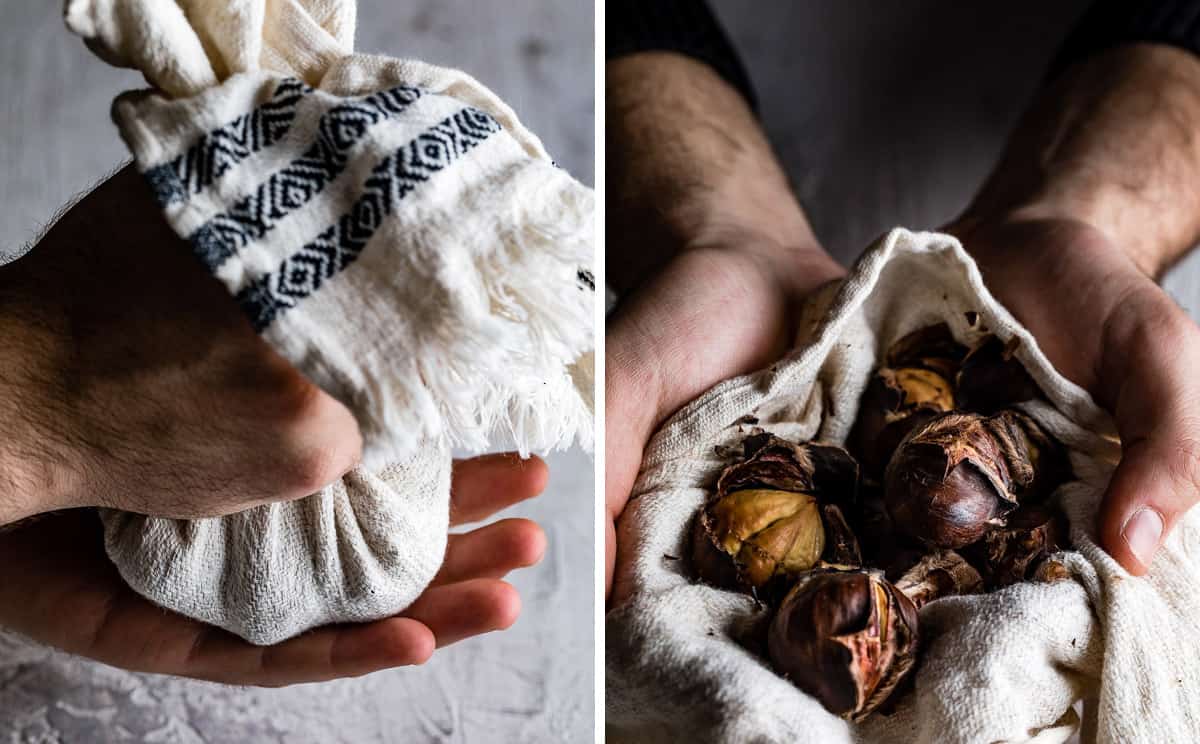
- Let them steam: Remove from the oven and place the now-roasted chestnuts in a clean kitchen towel or cloth. Collect the edges of the cloth in the middle and turn it into a small pouch. Let them steam in the “pouch” for 10-15 minutes.
Alternatively, you can use a paper bag. Simply place the hot roasted chestnuts in it, roll the bag trapping the steam inside and let it steam for 15 minutes. - Gently crack: Being careful not to burn yourself, gently squeeze chestnuts using the kitchen cloth or the paper bag as a shield to help remove the skins. You should hear the crackling sound of the roasted skins as you do so.
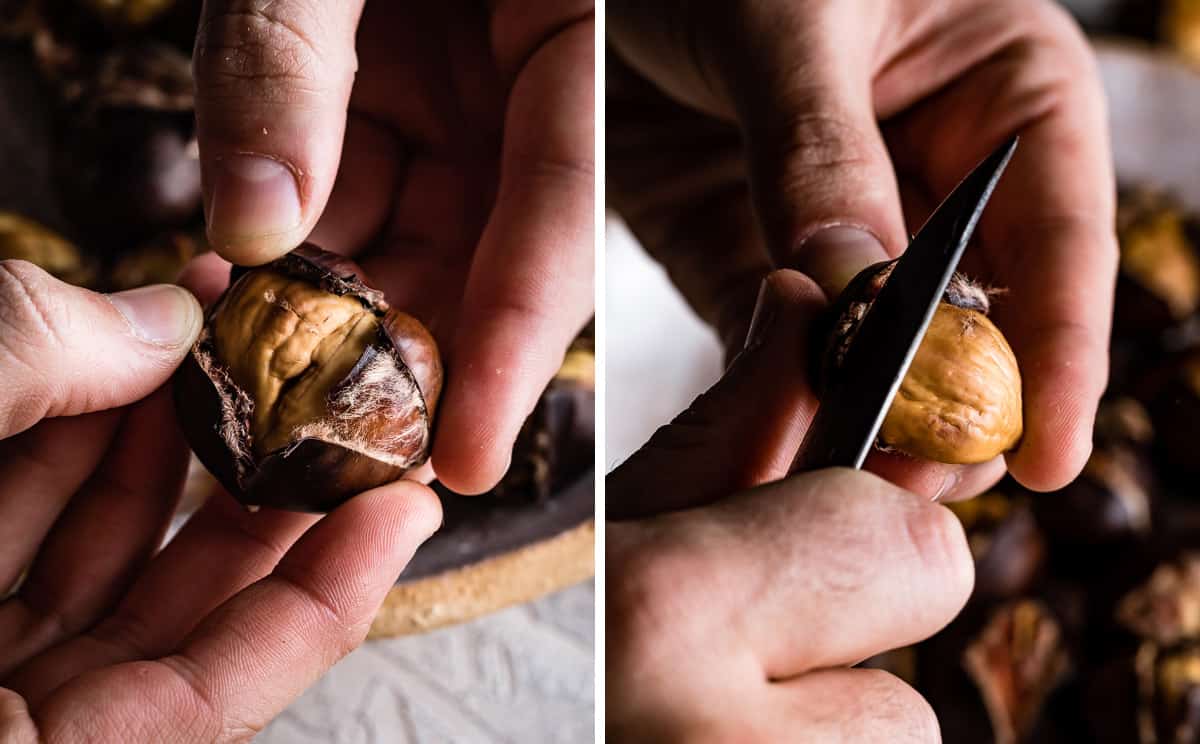
- Peel: Transfer the roasted chestnuts onto a platter and remove the outer shell of the chestnuts when they are still hot by gently pulling back on the scored “X”, peeling away the papery skin and exposing the yellow flesh inside. If you are unable to remove the fuzzy inner skin by hand, use a small sharp knife to peel it, being careful not to pierce the yellow nut inside. Discard the bad chestnuts that are spoiled inside.
A Word on Easy Peeling
If you do a quick Google search on how to easily peel chestnuts, you will see a lot of headlines claiming to share the easiest method that will get you perfectly and easily peeled chestnuts.
During the course of three weeks, in preparation for this post, I have tried several of those “easy” peeling methods. I learned one thing and it is that the ease of peeling depends on the type of chestnut you use. Yes, the method of cooking is important and you want to make sure they are fully cooked, but be aware that not every chestnut is created equal.
During my recipe testing, I found that Chinese chestnuts were very hard to peel, especially when it came to the inner skin (the fuzzy part), whereas Italian chestnuts were easier. However, even with the Italian chestnuts, there were some that broke as I was peeling.
It is also important to mention that the size and age of the chestnut play an important role when it comes to peeling. Based on all this, I think the rule of thumb when it comes to peeling is to be patient and keep a paring knife nearby if it gets hard to peel by hand.
How To Store?
What I love about roasted chestnuts is that you can easily bake a big batch, eat some right away, and store or freeze the rest for later. However, regardless of what you are planning to do with them, be sure to peel them while they are still warm as it will be very difficult to remove them from their shells after they are cooled to room temperature.
- Store: Place roasted chestnuts in an airtight container and store in the fridge for up to 4 days.
- Freeze: Place peeled chestnuts in a freezer bag, get the air out as much as you can, tightly seal, and freeze for up to 3 months.
- Thaw: Remove from the freezer and defrost in the fridge overnight.
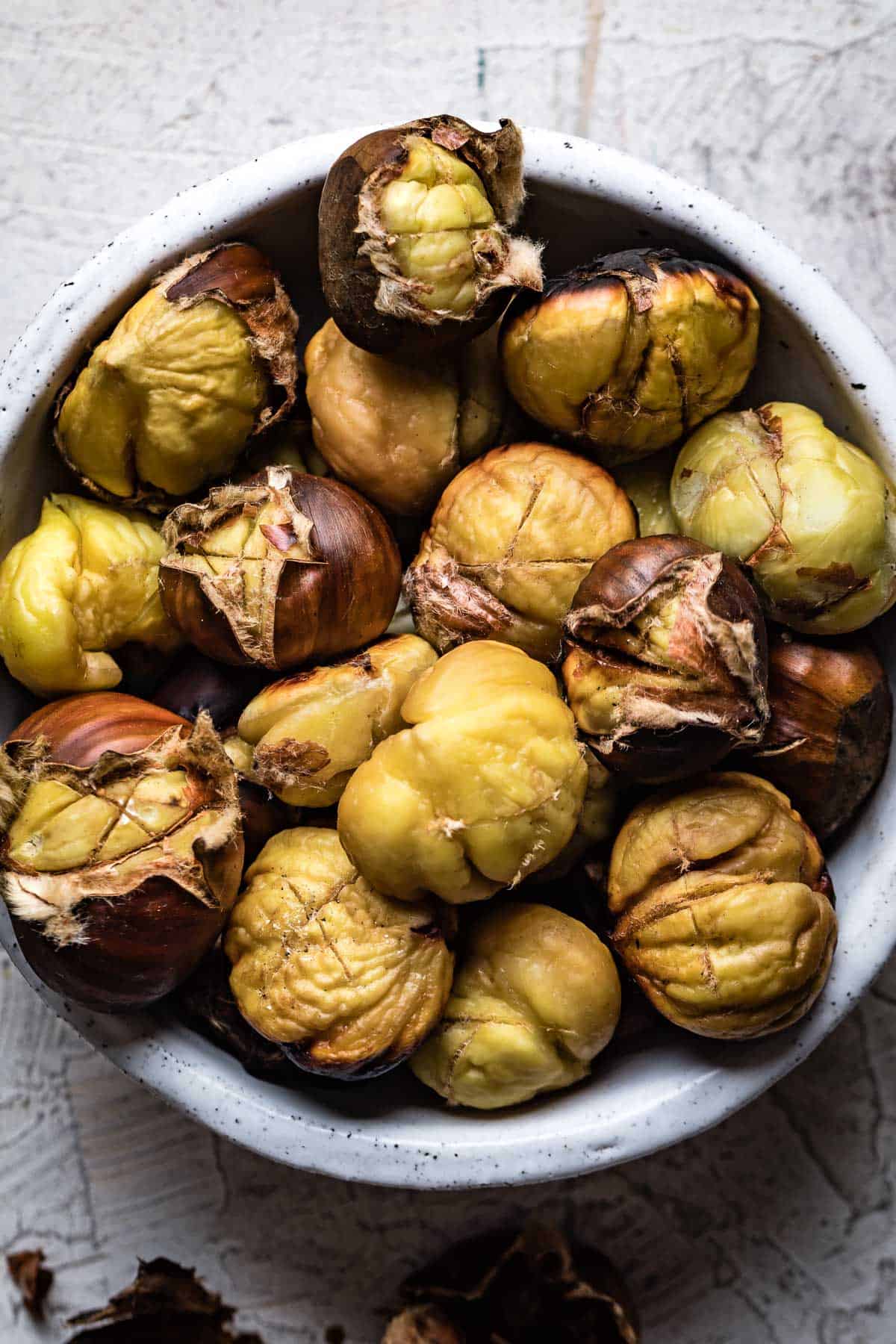
Seasoning Ideas:
While roasted chestnuts are perfect for snacking as they are, you can take them to the next level, especially during the holiday season. Here are a few ways to jazz up one pound of peeled chestnuts:
- My version of “Christmas Chestnuts”: Mix 4 tablespoons of melted butter with 1 tablespoons of sugar (or maple syrup) and ¼ teaspoon of ground cinnamon. Drizzle over the nuts or serve on the side for dipping. *This is my favorite way to serve on Christmas morning.*
- Apple pie spice flavored: Mix together 2 tablespoons of unsalted butter with 1 teaspoon apple pie spice and a pinch of ground nutmeg and drizzle over the baked chestnuts.
- Savory flavors: If you prefer more of a savory seasoning for roasted chestnuts, try mixing melted butter with your favorite herbs (such as chopped fresh rosemary or sage), sea salt, and black pepper.
How to Serve – What To Do With Chestnuts?
Use the below recipe to enjoy it by itself or use it in popular chestnut recipes such as:
- Chestnut puree
- Mont Blanc – A popular chestnut dessert
- Roasted Chestnut Soup
- Thanksgiving Chestnut Stuffing
- Candied Chestnuts
Expert Tips
While roasting chestnuts is a pretty straightforward process that doesn’t require much, there are a few things to know. Below are a few tips to help you succeed:
- Do not skip the scoring: I get it is not fun to have to go over every single chestnut and score them one by one. However, if you skip this part, it will likely explode in the oven. It happened to me and it was scary.
- Peel them while they are still hot: As soon as they are cool enough to handle, start peeling them or otherwise it will be very hard to remove them from their shells after they cooled down.
- Get more than you need: If you need a pound of shelled roasted chestnuts, I recommend you purchase a pound and a half. You will likely end up with a pound after you have removed the shells and tossed the ones that have gone bad.
- Toaster Oven: I tested this recipe both in my regular oven and toaster oven. If your toaster oven can go up to 425 degrees Fahrenheit, you can place them in a shallow roasting pan and follow the recipe as written.
- Soaking Time: Some people let the chestnuts soak overnight. During my testing, I tried both ways and found no difference in the end product. I also tried the method where you soak it in a bowl of hot water. But again, the end product was no different.
FAQs
When roasted, the outer shell of the chestnut will burst open and reveal the golden-brown flesh on the inside.
It is not necessary to boil chestnuts before roasting. However, I do recommend soaking them for an hour.
Place chestnut flat on a cutting board with the round side facing up. Hold it firmly in between your fingers and cut horizontally across the rounded side using a sharp paring knife, a sharp serrated knife, or a chestnut knife, if you have one.
I recommend roasting chestnuts for about 25-35 minutes at 425 degrees F. You can tell that they are done when the outer shells burst open revealing the golden flesh on the inside.
As long as they are stored in an airtight container in the refrigerator, roasted chestnuts will keep fresh for up to 4 days.
Yes, you can. However, according to this article on WebMD, they contain tannic acid which may result in stomach irritation, nausea, or liver damage in some people.
Roasted chestnuts have a slightly sweet, earthy, and nutty flavor with a buttery soft texture. Some people even find the flavor similar to a cooked sweet potato.
Store raw chestnuts, still in their shells, in a cool and dry place for about a week. If you want to store them longer, place them in a plastic bag and keep them in the fridge for up to a month.
You can eat a roasted chestnut by itself or use it in recipes like chestnut soup, chestnut puree, or even stuffing.
Other Snacks Recipes You Might Also Like:
Before I share a few more snack recipes, please know that I also have a detailed article on How to Boil Chestnuts and Roasting Chestnuts on an Open Fire. If you want to learn other ways of cooking chestnuts be sure to check those out.
- Roasted Delicata Squash
- Hamara Recipe
- Carrot Hummus
- Check out all our snacks recipes for more inspiration
If you found this post on How To Roast Chestnuts in Oven helpful and roasted chestnuts in your own kitchen, please take a minute to rate the recipe and leave a comment below. It helps others who are thinking of making the recipe. And if you took some pictures, be sure to share them on Instagram using #foolproofeats so I can share them on my stories.
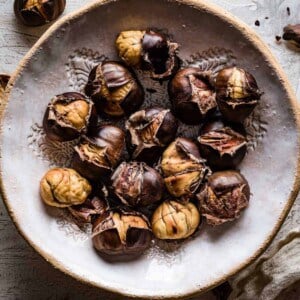
How to Roast Chestnuts in Oven – Oven Roasted Chestnuts Recipe
Ingredients
- 1 lbs Chestnuts, preferably Italian (or European) or chestnuts from Michigan
- Water
Instructions
- Place chestnuts in a colander and rinse under cold running water. Drain.
- Place the flat side of the chestnut down on a cutting board. The rounded side, (aka the belly side) should be facing up. Hold the chestnut firmly and cut horizontally across the rounded side using a sharp paring knife or a chestnut knife, if you have. Then turn the chestnut 90 degrees and make a second cut forming an X. As you are cutting, do your best not to score the inner skin. Continue with the rest of the chestnuts.
- Transfer the now-cut chestnuts into a bowl. Cover it with cold tap water and let them sit for an hour.
- Preheat it to 425 F degrees (218 C). Drain chestnuts (no need to dry) and place them on a baking sheet pan in a single layer. Roast for 25-30 minutes*1 keeping a close eye on it and turning a few times if necessary. They should be fully roasted when the skins have pulled back/opened and the flesh inside has softened.
- Remove from the oven and place the now-roasted chestnuts in a kitchen cloth. Collect the edges of the cloth in the middle and turn it into a small pouch. Let them steam in the “pouch” for 10-15 minutes. Alternatively, you can use a paper bag. Simply place the hot roasted chestnuts in it, roll the bag trapping the steam inside and let it steam for 10-15 minutes.
- Being careful not to burn yourself, gently squeeze chestnuts using the kitchen cloth or the paper bag as a shield to help remove the skins. You should hear the crackling sound of the roasted skins as you do so.
- To peel, transfer the roasted chestnuts onto a platter and remove the outer shell of the chestnuts when they are still hot by gently pulling back on the scored “X”, peeling away the papery skin and exposing the yellow flesh inside. If you are unable to remove the fuzzy inner skin by hand, use a small sharp knife to peel it, being careful not to pierce the yellow nut inside.*2 Discard the bad chestnuts that are spoiled inside.
- Enjoy roasted chestnuts on their own or use it with your favorite herbs or seasoning.
Video
Notes
- Roasting time *1: While I listed the roasting time as 25-30 minutes, I recommend that you keep an eye on the chestnuts after the 20-minute mark. In my experiments, some chestnuts were fully opened while the others were not, even after the full 30 minutes of roasting. So, it is a good idea to remove the ones that are fully opened and let the rest bake for a little longer, if necessary.
- A word on peeling *2: During the course of three weeks, in preparation for this post, I have tried several of the “easy” peeling methods I found in various websites and books. I learned one thing and it is that the ease of peeling depends on the type of chestnut you use. Yes, the method of cooking is important and you want to make sure they are fully cooked, but be aware that not every chestnut is created equal.
During my recipe testing, I found that Chinese chestnuts were very hard to peel, especially when it came to the inner skin (the fuzzy part), whereas Italian chestnuts were easier. However, even with the Italian chestnuts, there were some that broke as I was peeling.
It is also important to mention that the size and age of the chestnut play an important role when it comes to peeling. Based on all this, I think the rule of thumb when it comes to peeling is to be patient and keep a paring knife nearby if it gets hard to peel by hand. - Store: Place roasted chestnuts in an airtight container and store in the fridge for up to 4 days.
- Freeze: Place peeled chestnuts in a freezer bag, get the air out as much as you can, tightly seal, and freeze for up to 3 months.
- Thaw: Remove from the freezer and defrost in the fridge overnight.
Nutrition
Nutrition information is automatically calculated, so should only be used as an approximation.
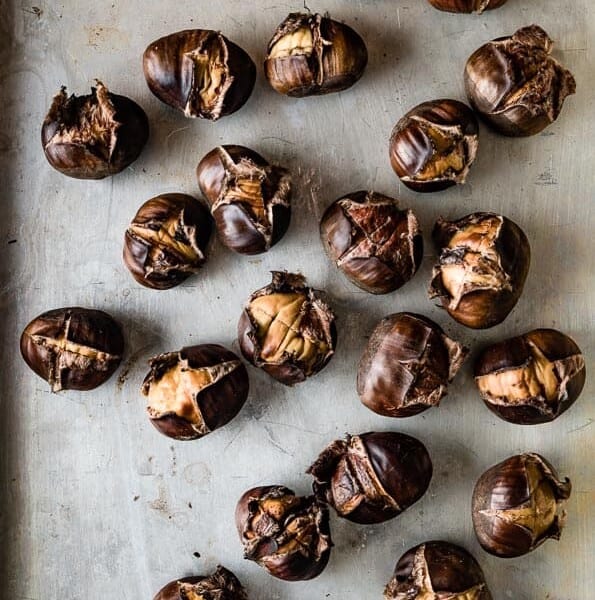



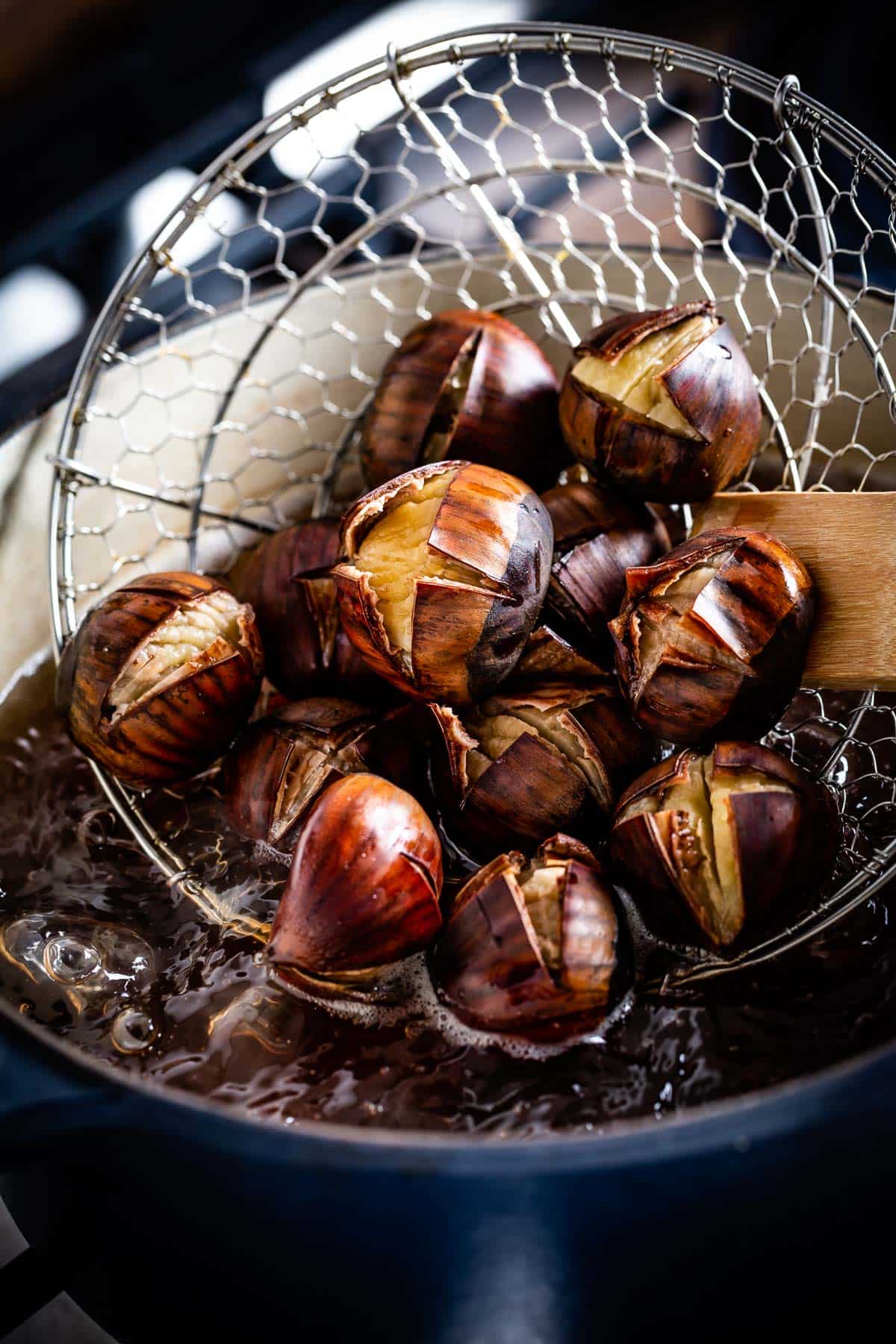










I find a utility knife, (some call it a box cutter, carpet or drywall knife) works very well. The handle & blade size make it easier and safer than using a regular knife. You also can find them at any hardware store or craft shop or on-line for a dollar or two.
Well said. Thanks for sharing.
Thank you for teaching us this process. The chestnuts turned out excellently.
This is music to my ears Vic B. Thanks so much for coming by and taking the time to leave a review.
This was a lot of effort, but it worked!
I am happy to hear that C.
Very helpful tips especially this is my first time roasting chestnuts and I was so afraid that it won’t go well. Thank you so much, I got my hands on Turkish chestnuts! They are so so sweet! ❤️
YAY! Happy to hear that this recipe/method worked for you Sara.